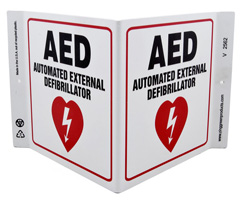



Find all of your laboratory and workplace safety supplies at Safety Emporium!
 Systemic |
 Glossary Index |
 Target organ effects |
| MSDS Topics |
Free Sites | FAQ's | Regulations | Glossary | Software | Suppliers |
| Books | Forum | Poll | Fun stuff | Quiz | Store | |
| Understand your MSDS with the MS-Demystifier | Search ALL our MSDS info | |||||
Tachycardia is a fast heart rate (100 beats per minute or faster in an adult).
This can be compared to bradycardia which is an unusually slow heart rate, usually signified by a pulse under 60 beats per minute.

Get your AED and other wall-projecting safety signs from Safety Emporium.
Tachycardia can be caused by exertion, strenuous exercise, emotions, hyperthyroidism (overactivity of the thyroid gland), disease, injury, heart disorders, or exposure to certain drugs or chemicals.
Ventricular tachycardia refers specifically to tachycardia that is initiated in the ventricles of the heart. You may have heard the slang "V-tach" used for this condition on medical television shows such as E.R.
Supraventricular tachycardia is initiated in the area of the heart above the ventricles and is sometimes abbreviated SVT.
There are many additional subtypes of tachycardia, but these are beyond the realm of focus here (Safety Data Sheets and related safety documents). See Further Reading below for more information.
This term usually appears in Section 11 (toxicological information) of a Safety Data Sheet as a symptom of chemical exposure. However, an abnormally fast heart rate could be due to chemical exposure, a heart attack, or simply a panic attack, among other causes. Read the SDS's of the chemicals you work with so you know if they can affect the heart rate or body chemistry. If you ever experience an unusual heart rate be sure to seek immediate medical attention.
See also: bradycardia, palpitation.
Additional definitions from Google and OneLook.
Entry last updated: Monday, January 16, 2023. This page is copyright 2000-2025 by ILPI. Unauthorized duplication or posting on other web sites is expressly prohibited. Send suggestions, comments, and new entry desires (include the URL if applicable) to us by email.
Disclaimer: The information contained herein is believed to be true and accurate, however ILPI makes no guarantees concerning the veracity of any statement. Use of any information on this page is at the reader's own risk. ILPI strongly encourages the reader to consult the appropriate local, state and federal agencies concerning the matters discussed herein.